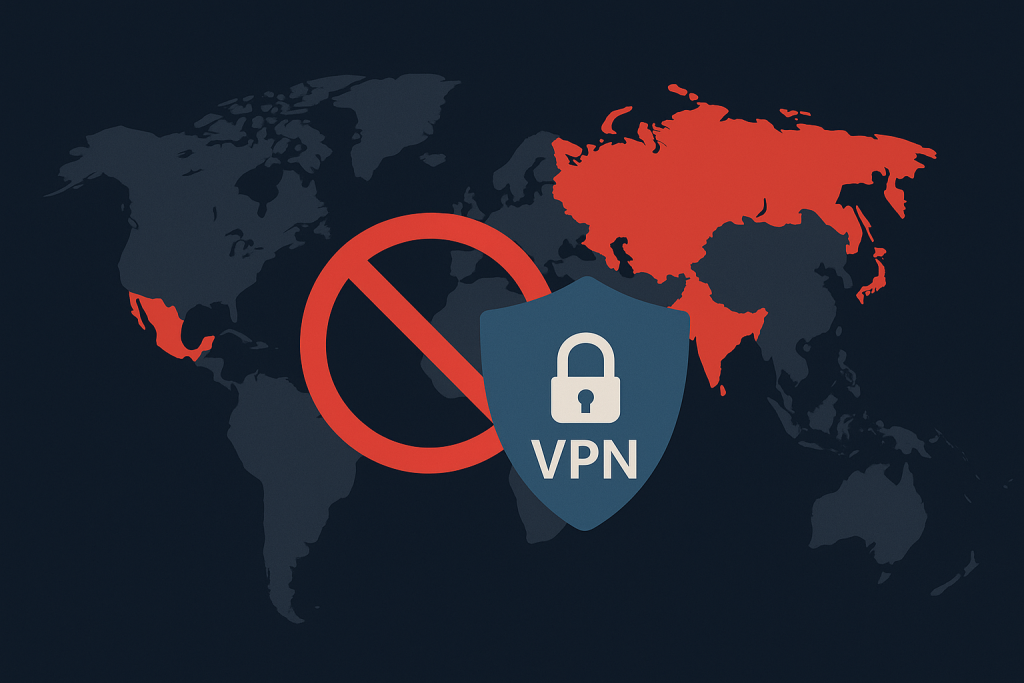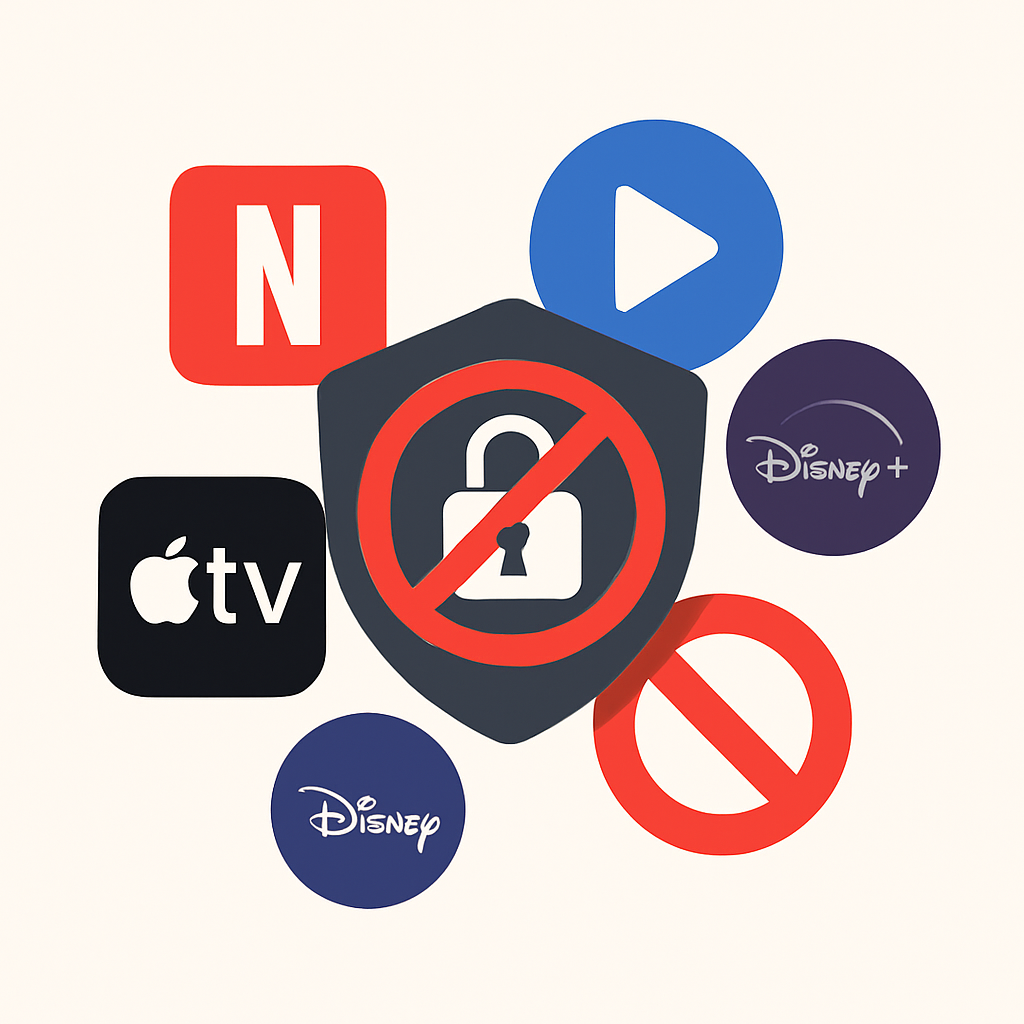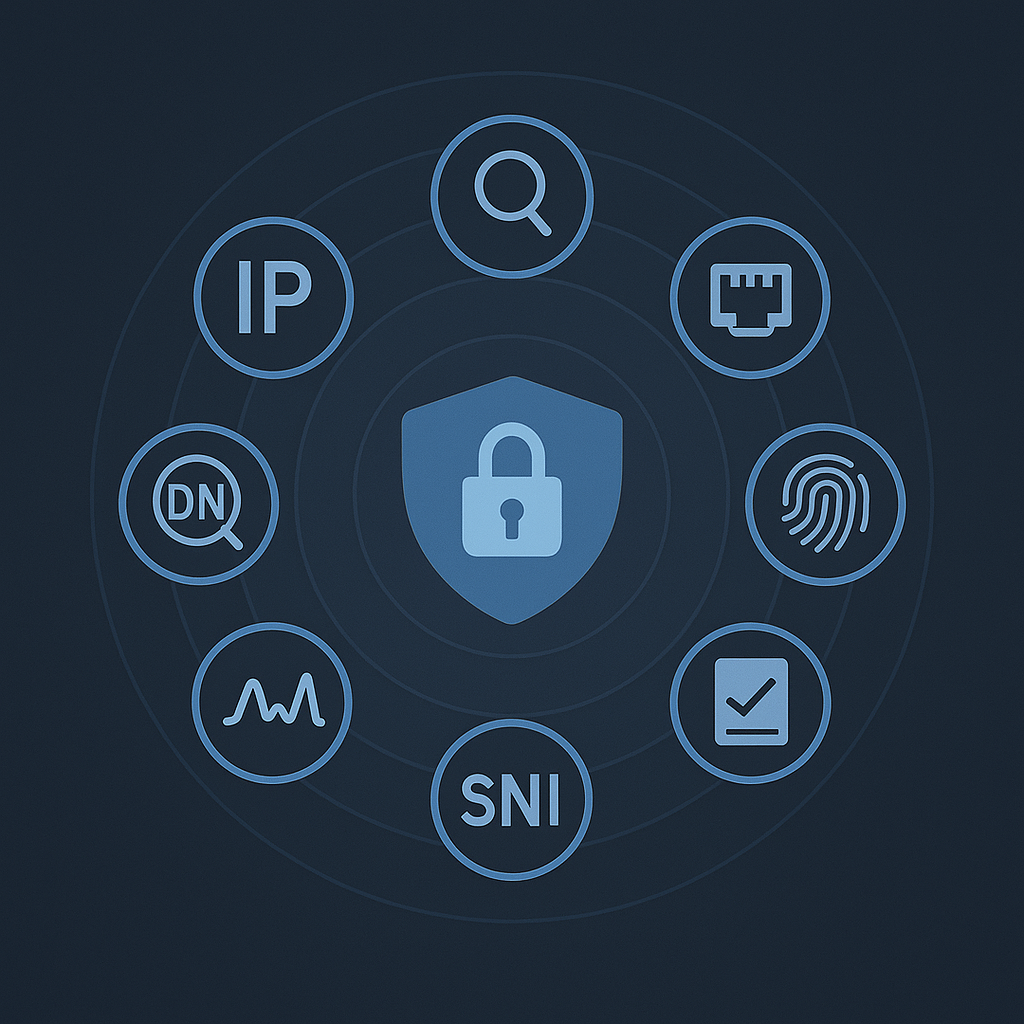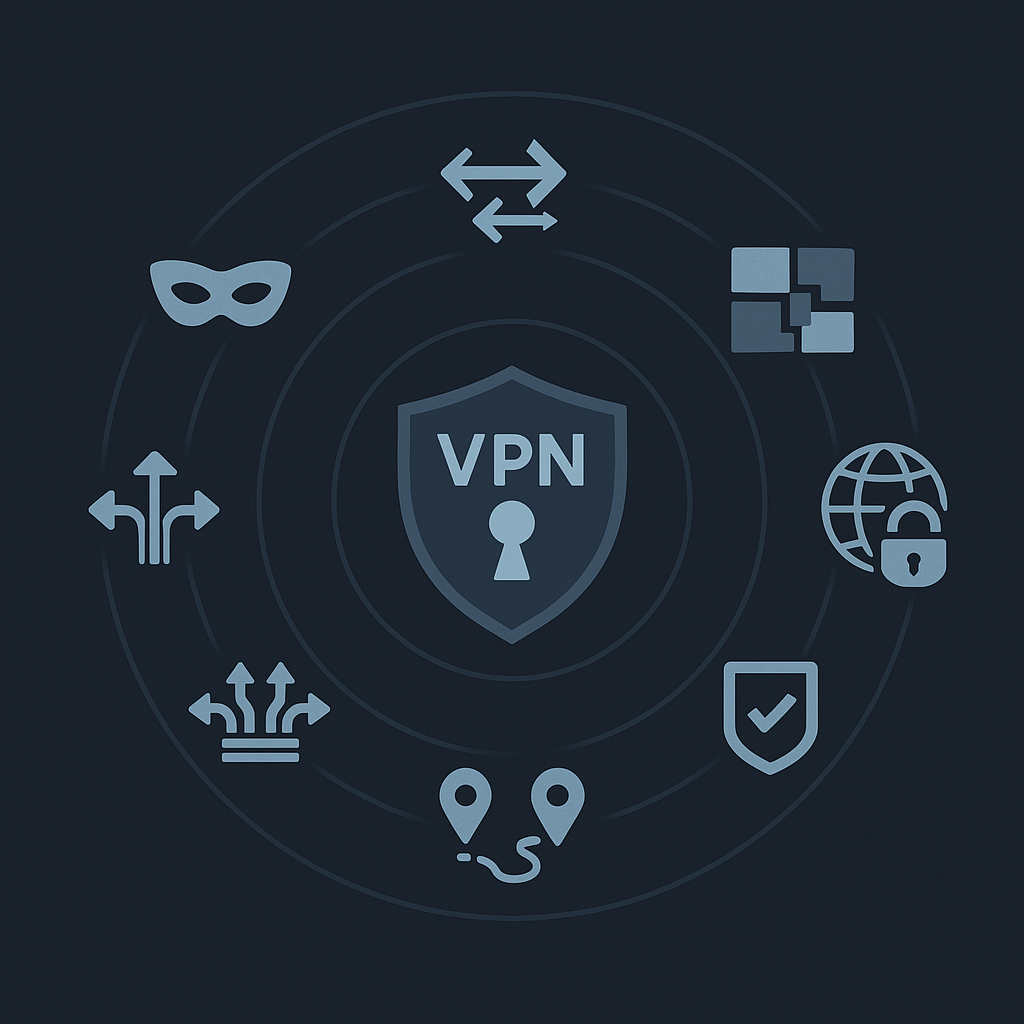Introduction
Did you ever fire up your VPN only to find it won’t connect? That’s VPN blocking at work. Across the globe – from strict governments to streaming giants—VPNs face roadblocks. In this article, we’ll dig into where and why VPNs get blocked and explore common VPN bypass tricks (hello, stealth protocols and obfuscation).

Also, just like in our previous articles on VPN security and VPN privacy, we’ll compare 12 top services on their real-world success at beating VPN restrictions around the world so you can pick the best VPN to bypass blocks for your needs.
VPN Censorship: Where and Why VPNs Get Blocked
Despite – or perhaps because of- VPN’s growing popularity, they rub up against walls built for different reasons. Some governments see encrypted tunnels as a threat to their censorship and surveillance regimes, leading to strict VPN blocking measures. Others worry that VPNs let users dodge content-licensing rules or skirt network policies. Even parents and schools sometimes block VPN traffic to keep filter settings intact. At its heart, VPN blocking boils down to control – who gets to see what, and where.
That begs the question: are VPNs even legal? In most places, yes – but legality alone doesn’t grant immunity from all blocks. Let’s break it down.
Where VPNs are legal
Most countries in the world, including the United States, Canada, the United Kingdom, Australia, EU states, and hundreds of others, have no VPN blocking laws and impose no outright ban on VPN use. However, there’s always a catch.
Let’s zoom in on the U.S. You might assume VPNs run free here, but you can still hit walls:
📺 Streaming giants like Netflix and Disney+ track down and block known data center VPN IP ranges to enforce their geo-licensing deals.
According to our survey, users claim having seen their VPN blocked by streaming platforms.
💻 Corporations and universities lock down VPN ports to stop employees and students from bypassing firewalls or using unauthorized remote access tools (say hi to your network sysadmin).
🔐 On the security front, certain agencies monitor VPN traffic for signs of data exfiltration or cyber espionage.
The same goes for places like Canada, the UK, and the Netherlands that generally allow VPN use but may still cooperate on legal data requests through intelligence-sharing pacts.
Where VPNs are illegal
There’s a handful of high-censorship countries that play it tough and totally ban VPN use to maintain full control over online content. Try installing a VPN app there, and you may face fines, confiscation, or worse:
- Iraq: All VPN use is outlawed.
- Belarus: Outlaws any anonymizing tools, including VPNs and Tor.
- Turkmenistan: Citizens swear off VPNs under penalty.
- North Korea: All independent VPN or proxy use is forbidden.
Countries with VPN restrictions
In some corners of the globe, VPNs are in the grey zone – end users can (most of the time) sleep well using encrypted tunnels, but strict regulations or targeted VPN blocking measures are in place. Let’s look at four heavy-handed jurisdictions and how they keep a lid on VPNs.
China
Beijing’s Great Firewall is legendary. It uses deep packet inspection (DPI) and SNI filtering to spot encrypted traffic. When it flags a VPN handshake, connections drop instantly. Users see time-outs or blank pages. Regular HTTPS browsing stays smooth-censors don’t want to break the web-but any hint of a tunnel gets scrubbed.
Russia
Since 2017, Russian law demands VPNs register with a government “allowlist.” Unregistered services often have their IPs added to a blocklist at the ISP level. SORM surveillance logs traffic patterns, so even stealth protocols can get flagged by behavioral analysis. Ordinary sites load fine, but users hunting for uncensored news hit dead ends or redirected block pages.
Turkey
Under broad “anti-terror” powers, Turkish ISPs throttle or block VPN ports on demand. They employ DNS interception to hijack lookups for VPN domains, then port blocking to slam the door shut. Streaming and social media work normally-but any effort to mask your location vanishes in a puff of “cannot connect” errors.
United Arab Emirates
The UAE’s telecom regulator cooperates with DPI-equipped firewalls, hunting VPN signatures on the fly. Unapproved VPNs often have their IPs blocklisted instantly. Even private businesses must use licensed, government-approved tunneling services. For residents, regular browsing and VoIP apps run fine-so long as they stick to the approved channels.
Across these nations, internet users adapt by chasing ever-new server IPs or digging up mirror domains. Still, the day-to-day web experience remains largely intact – censors focus surgical strikes on the tunnels, not the highways.
VPN status around the world:
| VPN status | Countries |
|---|---|
| Legal | U.S., Canada, UK, Australia, EU, Switzerland, India, Japan, Brazil, Mexico |
| Illegal | Iraq, Belarus, Turkmenistan, North Korea |
| Restricted | China, Russia, Iran, Turkey, United Arab Emirates, Oman |
Streaming platforms & VPN blocking: Real-life stories and stats
Blockers come in many shapes, but streaming platforms often set the harshest traps. Here are the heavy hitters:

- Netflix: Since September 2014, Netflix has been flagging and blocking known VPN IPs at the CDN layer, leading to endless loading screens or “Proxy Detected” errors. Although the platform doesn’t explicitly outlaw VPN usage, it underscores that you’ll only see shows and movies Netflix has worldwide rights for.
- Hulu: Hulu rejects VPN‑sourced requests if it can’t verify your geographical location. Legitimate U.S. users on VPNs can also get caught in the crossfire, unable to stream despite valid subscriptions.
- BBC iPlayer: The UK broadcaster checks IP ranges against public VPN pools and slams the door shut if they match for the same reason as Hulu. Expect an “Unavailable in your location” message even if you’re a UK resident on a VPN.
- Disney+: Just like the previous two platforms, Disney+ is actively kicking out VPN services by blocklisting their exit nodes. If you’re using a VPN, expect a “Disney+ is only available in certain regions” message even if you’re accessing the platform from a supported country or region.
- Amazon Prime Video: Amazon Prime Video doesn’t support streaming content through VPNs or proxy connections and actively blocks them, using a mix of IP blocklists and SNI inspection. Even if you’re trying to access the platform from the legit region, you’ll get the location error (if the VPN is exposed).
These platform-level bans aren’t just a minor inconvenience – they can turn your streaming session into a frustrating cycle of endless reloads and forced server hunts. The worst part is that there is no surefire solution, and all providers face blocks here and there, which is proved by endless subs on Reddit where users share their real-life experiences.
VPN Blocking Methods and Bypass Techniques
Providers spin up fresh servers → censors spot the new IPs and slam them shut → VPNs slip in stealth tricks or shuffle addresses → censors figure it out—and then the game starts all over. It’s the VPN circle of life. So how do VPNs still stay afloat despite this constant pressure and blocking threats?
🚨Spoiler: They always adapt!
This constant race drives innovation on both ends, resulting in emerging detection and bypassing techniques. So let’s peek at the methods one side uses to block VPN traffic and the other to get past it.
VPN blocking methods
Deep packet inspection
DPI tools peek inside data packets, a bit like airport security scanners. Instead of just checking where a packet’s going, they look at what it carries – handshakes, encryption headers, even packet size patterns. When a DPI appliance spots that signature OpenVPN hello or the typical WireGuard handshake, it flags the flow as VPN traffic and cuts it off. That makes it tough for a VPN to pass unnoticed unless it scrambles its metadata.
IP blocklisting
Since many VPNs use fixed IP ranges for their servers, censors do their best to track and add them to the blocklist. Any packet from those addresses gets dropped or redirected to a block page – until the provider rotates or replaces those addresses.
Port blocking
VPN protocols often use the same ports: OpenVPN loves 1194, L2TP leans on 1701, SSTP sits on 443. Network admins simply shut those doors. No port, no passage – your VPN client can’t even start the handshake.

It’s a blunt instrument: easy to deploy but also easy to spot. Any traffic on those ports that doesn’t match the expected protocol can get blocked too, which sometimes trips up non-VPN services.
TLS/SSL fingerprinting
Many VPNs wrap their traffic in TLS – just like secure websites. But the way a VPN client and server exchange certificates and start encryption isn’t identical to a browser talking to Google. Fingerprinting tools log those subtle differences in the handshake sequence.
DNS interception
Before your VPN can connect, it needs to resolve the provider’s domain to an IP. DNS interceptors hijack those lookups – either returning a false address or none at all. Without the right IP, your client can’t find the server.
Server Name Indication (SNI) inspection
When your browser – or VPN client – starts a TLS handshake, it sends a Server Name Indication field in plain text. And if it doesn’t match an approved hostname, the network drops the connection right at handshake time before any encryption kicks in, blocking VPN domains without even touching IPs or ports.
Behavioral analysis
Instead of hunting for specific fingerprints, some systems watch overall traffic habits – encrypted tunnels tend to show big bursts of data, uniform packet sizes, and oddly steady bitrates. Over minutes or hours, these “high-entropy” patterns flag VPN-like behavior – even if the protocol itself is hidden.
It’s less precise than DPI but harder to trick, since it looks at how you move, not just what your packets look like. And it’s only getting worse – modern firewalls feed encrypted traffic metadata into machine learning models that learn to spot these VPN‑like patterns, timing quirks, and protocol anomalies at scale. Unlike static DPI rules, these systems adapt in real time – so the moment a new stealth trick emerges, the AI can retrain itself to flag any remaining traces.
Certificate pinning checks
Some corporate or mobile networks enforce strict certificate rules: only connections presenting a known, pinned certificate chain get through. When your VPN server’s cert differs from the expected fingerprint, the client or network refuses to talk.
How VPNs bypass these blocks
Obfuscation & stealth protocols
Obfuscation scrambles VPN traffic so it looks like ordinary HTTPS. It wraps OpenVPN or WireGuard inside an SSL or SSH layer, tweaks TLS packet headers, or randomizes handshake sequences so they no longer match known VPN fingerprints.
Protocols like Stunnel or proprietary stealth modes from top providers make VPN data wear a convincing disguise. Obfuscation and stealth protocols are also the most effective parental control VPN bypass technique.
Port switching
Running VPN over port 443 – the same lane as secure web traffic – lets it sneak under the radar. Since most firewalls can’t block HTTPS without breaking every site, port 443 becomes a safe harbor.
Packet fragmentation
Rather than sending a full handshake in one chunk, the VPN splits it into tiny pieces. So while a DPI tool expects the handshake in one block, fragmentation forces it to reassemble before inspecting, slowing or confusing the process.
TCP/UDP randomization
Here, a VPN shuffles packet sizes, timing, and even the port numbers midstream. Fingerprinters that rely on consistent patterns get thrown off. One moment your traffic looks like video streaming, the next it mimics VoIP blips.

Multi-hop routing
Instead of a direct tunnel, traffic hops through two or more VPN servers in different jurisdictions. If the first server’s IP gets blocklisted, the second hop still carries your data onwards.
DNS-over-HTTPS (DoH) inside the tunnel
Normally, DNS lookups happen outside the VPN, leaving them vulnerable to interception. By forcing DNS queries through an encrypted DoH channel inside your VPN, you stop censors from hijacking or blocking those lookups.
Alternative domain fronting
Here, the VPN server masquerades as a high-profile domain (like a cloud provider’s service) during the TLS handshake. Censors see only that approved domain in DNS and SNI fields, so they let the connection proceed – never realizing the real target lies beyond.
Encrypted SNI (ESNI)/TLS 1.3 Encrypted Client Hello (ECH)
With ESNI (now part of TLS 1.3), the SNI field itself gets encrypted. By hiding that initial “who are you talking to?” step, censors no longer see which hostname you’re targeting, so SNI-based blocks fail.
Traffic shaping & padding
To confuse behavioral analysis, VPNs can insert dummy bytes or maintain a constant data rate. This padding masks the typical burst-and-pause signature of encrypted tunnels, making traffic look like random web chatter.
Valid certificate rotation
To satisfy pinning checks, VPN providers regularly swap in certificates signed by widely trusted CAs. By matching the expected cert chain, connections sail through pinning filters without raising alarms.
Performance & reliability trade-offs
💭Remember: every clever dodge comes at a cost. Obfuscation, multi‑hop, and padding add extra hops or data overhead – expect your speeds to drop by 5-30%, depending on the method.
Packet fragmentation and randomization can confuse censors, but they also increase latency and CPU load on both client and server.
- Stealth modes (obfuscation, TLS wraps) boost invisibility, but they chew up bandwidth and take longer to negotiate.
- Multi‑hop routing adds resilience, yet each extra hop adds network lag.
- Traffic shaping & padding hide behavioral patterns – at the price of sending dummy data that your device still has to process.
- DoH and ESNI protect your DNS and SNI, but they may fail on older devices or networks that don’t support TLS 1.3.
In short, the fancier the stealth, the more overhead – so it’s a balancing act between staying hidden and staying speedy.
Blocking methods vs. VPN bypass tactics:
| Blocking method | What it does | Effectiveness | VPN bypass tactics |
|---|---|---|---|
| Deep packet inspection | Scans packet contents for VPN signatures | High | ▪️Obfuscation & stealth protocols ▪️Packet fragmentation ▪️TCP/UDP randomization |
| IP blacklisting | Drops traffic from known VPN server addresses | Medium | ▪️Fresh IP rotation & dynamic server pools ▪️Multi-hop routing |
| Port blocking | Shuts common VPN ports (1194, 1701, etc.) | Medium | ▪️Port switching to 443/TCP over HTTPS ▪️Obfuscation (to blend traffic) ▪️Custom port hopping |
| TLS/SSL fingerprinting | Detects non-browser TLS handshakes | High | ▪️Proprietary TLS wraps ▪️Randomized handshake sequences ▪️Stunnel/SSH tunneling |
| DNS interception | Hijacks or blocks VPN domain lookups | Medium | ▪️Hardcoded IP lists in client ▪️DNS-over-HTTPS inside the tunnel ▪️Alternative domain fronting |
| SNI inspection | Blocks based on the SNI field in TLS Client Hello | High | ▪️ESNI/TLS 1.3 ECH ▪️Alternative domain fronting |
| Behavioral analysis | Detects VPN-like traffic patterns over time | High | ▪️Traffic shaping & padding ▪️TCP/UDP randomization ▪️Obfuscation & stealth protocols |
| Certificate pinning checks | Rejects cert chains that don’t match expected CA | Medium | ▪️Valid certificate rotation ▪️Proprietary TLS wraps |
As you can see, no matter how hard censors try, VPNs still find ways to shrug off IP bans, port cuts, fingerprinting nets, whatever – never letting the light at the end of your encrypted tunnel go down.
Choosing the Best VPN to Bypass Blocks
We’ve mapped out the VPN blocking battlefield – why walls go up and how tunnels adapt. Now that we know all the tips and tricks, let’s take stock of which services are doing the best job at breaking through these walls. First, let’s sum up the features your provider has to offer to be able to effectively bypass VPN bans.
Key features to look for
When you hunt for a VPN that laughs in the face of blocklists and protocol sniffs, keep these factors front and center:
- Server count & location diversity: More servers across more countries mean you can switch IPs on the fly when one pool gets blocklisted.
- Stealth & obfuscation: Proprietary stealth modes and TLS wraps help your traffic masquerade as regular HTTPS.
- Multi‑hop (or double VPN): Chaining servers adds resilience – if one hop gets nailed, your data still finds a backdoor.
- Smart DNS support: If your sole goal is to geo-unblock streaming libraries, Smart DNS is the way to go. It skips encryption (your ISP sees everything that you do) and doesn’t help against DPI and other checks, only tricking geo‑checks on DNS‑level services, but it is still usually enough for most major streaming platforms. And it eats up almost zero bandwidth – perfect for long 4K streaming sessions.
- Server speed: High‑throughput networks (10 Gbps+) help offset the overhead of obfuscation and padding.
- Jurisdiction: VPNs based in privacy‑friendly countries (Switzerland, Panama, Sweden) avoid local data retention laws that could force them to cooperate on blocklists. Make sure to check this article to learn more about jurisdictions, and pay attention to who owns your VPN provider—their jurisdiction may not be as pretty.
Apart from knowing which features to look for, it’s important to match your case with the right toolkit before making a decision. Here’s your go‑to checklist:
For streaming access, use a VPN when:
- Smart DNS support for zero‑lag unblocking.
- Stealth/obfuscation modes to slip past platform IP bans.
- High server count & location diversity so you can rotate quickly.
- Top speeds (10 Gbps+ backbones) to offset encryption overhead.
If you’re bypassing government‑level blocks:
- Obfuscation & stealth protocols for hiding your use of VPN and DPI check bypassing.
- Multi‑hop for extra resilience.
- Secure jurisdiction with strong privacy laws.
If you’re sneaking past school or company filters:
- Obfuscation & stealth protocols that mask VPN handshakes and make your traffic look like a regular connection.
💡Pro tip: Always check your sysadmin’s policy first – some blocks are there for a reason.
Does your VPN live up to it?
Finally, let’s see if our 12 contenders can be called true VPN blockbusters. Here’s a quick overview, with key stats:
| 40 Gbps | Servers | Countries | Stealth & advanced obfuscation | Jurisdiction (parent company jurisdiction) | Multi‑hop | Smart DNS | Max speed |
|---|---|---|---|---|---|---|---|
| Proton VPN | 13,700 | 122 | ▪️Built-in Stealth protocol ▪️TLS obfuscation ▪️Automatic cert rotation | Switzerland (Switzerland) | Yes | Yes | 10 Gbps |
| NordVPN | 7,400+ | 118 | ▪️NordLynx protocol ▪️Obfuscated servers ▪️TLS obfuscation ▪️Automatic cert rotation | Panama (The Netherlands) | Yes | Yes | 10 Gbps |
| ExpressVPN | 3,000+ | 105 | ▪️Lightway protocol ▪️OpenVPN obfuscation ▪️TLS obfuscation ▪️Automatic cert rotation | British Virgin Islands (UK) | No | Yes | 10 Gbps |
| Surfshark | 3,200+ | 100 | ▪️NoBorders ▪️TLS obfuscation | The Netherlands (The Netherlands) | Yes | Yes | 10 Gbps |
| CyberGhost | 9,000+ | 100 | No | Romania (UK) | No | Yes | 10 Gbps |
| VyprVPN | 700+ | 63 | ▪️Chameleon protocol | United States (United States) | No | No | N/A |
| Private Internet Access (PIA) | 16,000+ | 91 | ▪️Proxy‑based obfuscation ▪️Shadowsocks obfuscation | United States (UK) | Yes (proxy chains) | Yes | 10 Gbps |
| Windscribe | N/A | 69 | ▪️Stealth & WStunnel protocols ▪️Split Personality | Canada (Canada) | Yes | No | 10 Gbps |
| TunnelBear | 8,000+ | 47 | ▪️GhostBear ▪️ESNI support | Canada (United States) | No | No | N/A |
| Hotspot Shield | 1,800+ | 85 | ▪️Hydra protocol | United States (United States) | No | No | N/A |
| Norton VPN | 2,800+ | 29 | ▪️Mimic protocol | United States (United States) | No | No | N/A |
| Mullvad | 730+ | 49 | ▪️Shadowsocks obfuscation ▪️TLS obfuscation ▪️Automatic cert rotation ▪️DAITA | Sweden (Sweden) | Yes (except Android) | No | 40 Gbps |
With massive server fleets and built‑in Smart DNS, Proton VPN, NordVPN, ExpressVPN, and Surfshark top the charts for streaming. They cover 100+ countries, pack stealth modes that sneak past Netflix and BBC iPlayer barriers, and deliver 10 Gbps backbones to keep UHD streams buffer‑free.
Toss in fast Lightway or NordLynx protocols, and you’ve got near‑zero lag when you hop between catalogs. Although Mullvad lacks the Smart DNS feature and may fall behind on the server count, it makes up for it with lightning-fast 40 Gbps servers that will ensure max quality video without delays. PIA can also be added to this top list with its massive server count.
For when you need an all‑terrain VPN that handles everything from government DPI to campus firewalls, Proton VPN, NordVPN, Surfshark, and Mullvad are your go-to choices, with the latter deserving an extra point for their DAITA feature that helps defend against AI-guided traffic analysis that is becoming a growing threat.
They all live under privacy-friendly jurisdictions and pack multi-hop and other advanced features to bypass VPN blocking and strict censorship. Windscribe, although it operates under the Five Eyes country jurisdiction, also excels at bypassing blocks, providing all the necessary features to keep your traffic hidden.
Conclusion
📌Bottom line: no provider is immune to VPN blocking, so you may still face shut doors and location errors – even with the best picks.
However, it’s still worth selecting the most resilient option that best suits your use case to minimize the risks.
And hey, always choose a paid service, as free VPN IPs are well-known and always get blocked first.
Enjoyed this article? Share it with friends-and stay tuned for more!





